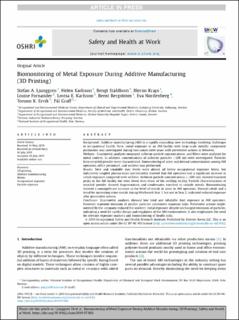| dc.contributor.author | Ljunggren, Stefan A. | |
| dc.contributor.author | Karlsson, Helen | |
| dc.contributor.author | Ståhlbom, Bengt | |
| dc.contributor.author | Krapi, Blerim | |
| dc.contributor.author | Fornander, Louise | |
| dc.contributor.author | Karlsson, Lovisa E. | |
| dc.contributor.author | Bergström, Bernt | |
| dc.contributor.author | Nordenberg, Eva | |
| dc.contributor.author | Ervik, Torunn Kringlen | |
| dc.contributor.author | Graff, Pål | |
| dc.date.accessioned | 2022-04-25T11:03:37Z | |
| dc.date.available | 2022-04-25T11:03:37Z | |
| dc.date.created | 2019-08-12T09:24:56Z | |
| dc.date.issued | 2019 | |
| dc.identifier.citation | SH@W Safety and Health at Work. 2019, 1-9. | |
| dc.identifier.issn | 2093-7911 | |
| dc.identifier.uri | https://hdl.handle.net/11250/2992521 | |
| dc.description.abstract | Background: Additive manufacturing (AM), is a rapidly expanding new technology involving challenges to occupational health. Here, metal exposure in an AM facility with large-scale metallic component production was investigated during two consecutive years with preventive actions in-between. Methods: Gravimetric analyzes measured airborne particle concentrations and filters were analyzed for metal content. In addition, numbers of airborne particles < 300nm were investigated. Particles from recycled powder were characterized. Biomonitoring of urine and dermal contamination among AM operators, office personnel and welders was performed. Results: Total and inhalable dust levels were almost all below occupational exposure limits but ICP-MS showed that AM operators had a significant increase of cobalt exposure compared to welders. Numbers of airborne particles (<300nm) showed transient peaks in the AM facility but were lower than in the welding facility. Particle characterization of recycled powder showed fragmentation and condensates enriched in volatile metals. Biomonitoring showed a non-significant increase of urine metals in AM operators. Dermal cobalt and a trend for increasing urine metals during a work-week year in 1, but not in year 2, indicated reduced exposure after preventive actions. Conclusion: Gravimetric analyses show low total and inhalable dust exposure in AM operators. However, transient emission of smaller particles constitutes exposure risks. Preventive actions implemented by the company reduced the workers metal exposure despite unchanged emissions of particles, indicating a need for careful design and regulation of the AM environments. It also emphasizes the need for relevant exposure markers and biomonitoring of health risks. | |
| dc.description.abstract | Biomonitoring of Metal Exposure During Additive Manufacturing (3D Printing) | |
| dc.language.iso | eng | |
| dc.title | Biomonitoring of Metal Exposure During Additive Manufacturing (3D Printing) | |
| dc.type | Peer reviewed | |
| dc.type | Journal article | |
| dc.description.version | publishedVersion | |
| dc.source.pagenumber | 1-9 | |
| dc.source.journal | SH@W Safety and Health at Work | |
| dc.identifier.doi | 10.1016/j.shaw.2019.07.006 | |
| dc.identifier.cristin | 1715211 | |
| cristin.unitcode | 7476,0,0,0 | |
| cristin.unitname | Statens arbeidsmiljøinstitutt | |
| cristin.ispublished | true | |
| cristin.fulltext | original | |
| cristin.qualitycode | 1 | |
